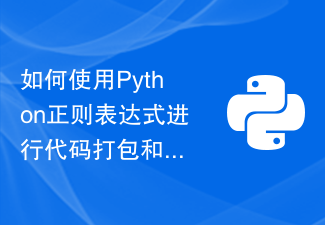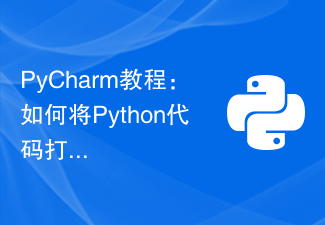 Java
Java javaTutorial
javaTutorial Introduction to Maven project packaging steps: step-by-step implementation of project packaging and release
Introduction to Maven project packaging steps: step-by-step implementation of project packaging and release
Introduction to Maven project packaging steps: Step by step implementation of project packaging and release requires specific code examples
With the continuous development of the software development industry, Maven is an excellent Project management tools play an important role in project construction. Maven can not only help us manage project dependencies, but also package and release the project through a series of instructions. This article will briefly introduce the steps of Maven project packaging and provide specific code examples to help readers have a deeper understanding and mastery of the Maven project packaging process.
- Ensure that the Maven environment is configured successfully
Before packaging the project, first ensure that Maven has been configured in the local environment. You can check the Maven version and configuration by entering mvn -v on the command line. If the Maven version information is displayed, the Maven environment configuration has been successful.
- Execute the packaging instructions in the project root directory
Open the command line, enter the root directory of the project that needs to be packaged, and then execute the following Maven packaging instructions:
mvn clean package
Among them, clean means clearing previously compiled files, and package means packaging the project. After executing this command, Maven will generate a packaged jar package or war package in the target directory of the project, depending on the type of project.
- Specify the packaging output directory
Sometimes we need to output the packaged files to the specified directory. You can add -Dmaven after the packaging command. test.skip=true to skip the test, and specify the output directory through -Dmaven.build.dir=/path/to/output, the specific example is as follows:
mvn clean package -Dmaven.test.skip=true -Dmaven.build.dir=/path/to/output
In this way, after executing the packaging command, the generated packaging file will be output to the specified /path/to/output directory.
- Execute custom plug-ins
Sometimes we need to perform some custom operations during the Maven packaging process, which can be done by pom.xml Configure the plug-in to achieve this. The following is a configuration example of a custom plug-in:
<build>
<plugins>
<plugin>
<groupId>org.apache.maven.plugins</groupId>
<artifactId>maven-compiler-plugin</artifactId>
<version>3.8.1</version>
<configuration>
<source>1.8</source>
<target>1.8</target>
</configuration>
</plugin>
</plugins>
</build> In this example, the maven-compiler-plugin plug-in is configured and the version of the compiled source code is specified to be 1.8.
- Publish to the warehouse
When the project packaging is completed, sometimes we need to publish the packaged files to the Maven warehouse or private warehouse for others or other projects Quote. You can publish to the Maven repository by executing the following command:
mvn clean deploy
By executing the deploy command, Maven will publish the packaged files to the configured Maven repository.
Through the above steps, we can easily use Maven to complete the packaging and publishing of the project. Maven, as a powerful project management tool, provides great convenience for our project development process. I hope that readers can better understand and master the Maven project packaging process through the introduction of this article, and improve the development efficiency and management level of the project.
The above is the detailed content of Introduction to Maven project packaging steps: step-by-step implementation of project packaging and release. For more information, please follow other related articles on the PHP Chinese website!
 分享PyCharm项目打包的简易方法Dec 30, 2023 am 09:34 AM
分享PyCharm项目打包的简易方法Dec 30, 2023 am 09:34 AM简单易懂的PyCharm项目打包方法分享随着Python的流行,越来越多的开发者使用PyCharm作为Python开发的主要工具。PyCharm是功能强大的集成开发环境,它提供了许多方便的功能来帮助我们提高开发效率。其中一个重要的功能就是项目的打包。本文将介绍如何在PyCharm中简单易懂地打包项目,并提供具体的代码示例。为什么要打包项目?在Python开发
 如何使用Python正则表达式进行代码打包和分发Jun 23, 2023 am 09:31 AM
如何使用Python正则表达式进行代码打包和分发Jun 23, 2023 am 09:31 AM随着Python编程语言的日益流行,越来越多的开发者开始使用Python编写代码。但是在实际使用中,我们常常需要将这些代码打包并分发给其他人使用。本文将介绍如何使用Python正则表达式进行代码打包和分发。一、Python代码打包在Python中,我们可以使用setuptools和distutils等工具来打包我们的代码。这些工具可以将Python文件、模块
 怎么使用pkg将Node.js项目打包为可执行文件?Jul 26, 2022 pm 07:33 PM
怎么使用pkg将Node.js项目打包为可执行文件?Jul 26, 2022 pm 07:33 PM如何用pkg打包nodejs可执行文件?下面本篇文章给大家介绍一下使用pkg将Node.js项目打包为可执行文件的方法,希望对大家有所帮助!
 linux打包是什么意思Feb 23, 2023 pm 06:30 PM
linux打包是什么意思Feb 23, 2023 pm 06:30 PM在linux中,打包指的是一个文件或目录的集合,而这个集合被存储在一个文件中;简单来说,打包是指将一大堆文件或目录变成一个总的文件。打包文件没有经过压缩,因此它占用的空间是其中所有文件和目录的总和。
 Python 代码变身独立应用:PyInstaller 的炼金术Feb 19, 2024 pm 01:27 PM
Python 代码变身独立应用:PyInstaller 的炼金术Feb 19, 2024 pm 01:27 PMPyInstaller是一个开源库,允许开发者将python代码编译为平台无关的自包含可执行文件(.exe或.app)。它通过将Python代码、依赖项和支持文件打包在一起来实现这一目标,从而创建独立应用程序,无需安装Python解释器即可运行。PyInstaller的优势在于它消除了对Python环境的依赖性,使应用程序可以轻松分发和部署给最终用户。它还提供了构建器模式,使用户可以自定义应用程序的设置、图标、资源文件和环境变量。使用PyInstaller打包Python代码安装PyInstal
 Python 应用的独立宣言:PyInstaller 的自由之路Feb 20, 2024 am 09:27 AM
Python 应用的独立宣言:PyInstaller 的自由之路Feb 20, 2024 am 09:27 AMPyInstaller:Python应用的独立化PyInstaller是一款开源的python打包工具,它将Python应用程序及其依赖项打包为一个独立的可执行文件。这一过程消除了对Python解释器的依赖,同时允许应用程序在各种平台上运行,包括windows、MacOS和linux。打包过程PyInstaller的打包过程相对简单,涉及以下步骤:pipinstallpyinstallerpyinstaller--onefile--windowedmain.py--onefile选项创建一个单一
 Python 应用的终极进化:PyInstaller 的破茧成蝶Feb 19, 2024 pm 03:27 PM
Python 应用的终极进化:PyInstaller 的破茧成蝶Feb 19, 2024 pm 03:27 PMPyInstaller是一个革命性的工具,它赋予python应用程序以超越其原始脚本形态的能力。通过将Python代码编译成独立的可执行文件,PyInstaller解锁了代码分发、部署和维护的新境界。从单一脚本到强大应用程序以往,Python脚本只存在于特定的Python环境中。分发这样的脚本需要用户安装Python和必要的库,这是一个费时且繁琐的过程。PyInstaller引入了打包的概念,将Python代码与所有必需的依赖项组合成一个单独的可执行文件。代码打包的艺术PyInstaller的工
 PyCharm教程:如何将Python代码打包成EXE文件Feb 21, 2024 pm 12:12 PM
PyCharm教程:如何将Python代码打包成EXE文件Feb 21, 2024 pm 12:12 PM在本文中,我们将介绍PyCharm中的一种常用方法,通过使用PyInstaller将Python代码打包成可执行的EXE文件。PyInstaller是一个用于将Python应用程序转换为独立的可执行文件的工具,它可以将Python代码打包成EXE、APP、Linux等格式,方便用户在没有安装Python解释器的环境中运行Python程序。步骤一:安装PyIn


Hot AI Tools

Undresser.AI Undress
AI-powered app for creating realistic nude photos

AI Clothes Remover
Online AI tool for removing clothes from photos.

Undress AI Tool
Undress images for free

Clothoff.io
AI clothes remover

AI Hentai Generator
Generate AI Hentai for free.

Hot Article

Hot Tools

Dreamweaver CS6
Visual web development tools

Zend Studio 13.0.1
Powerful PHP integrated development environment

Safe Exam Browser
Safe Exam Browser is a secure browser environment for taking online exams securely. This software turns any computer into a secure workstation. It controls access to any utility and prevents students from using unauthorized resources.

SublimeText3 Mac version
God-level code editing software (SublimeText3)

Atom editor mac version download
The most popular open source editor





